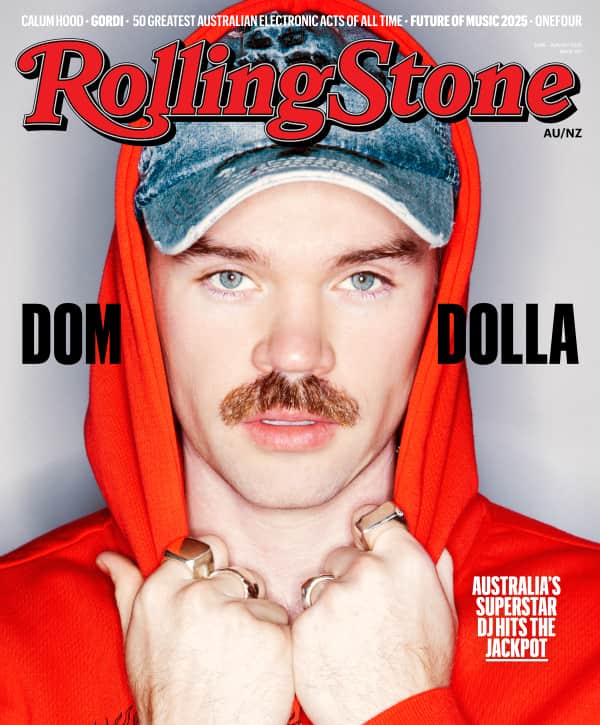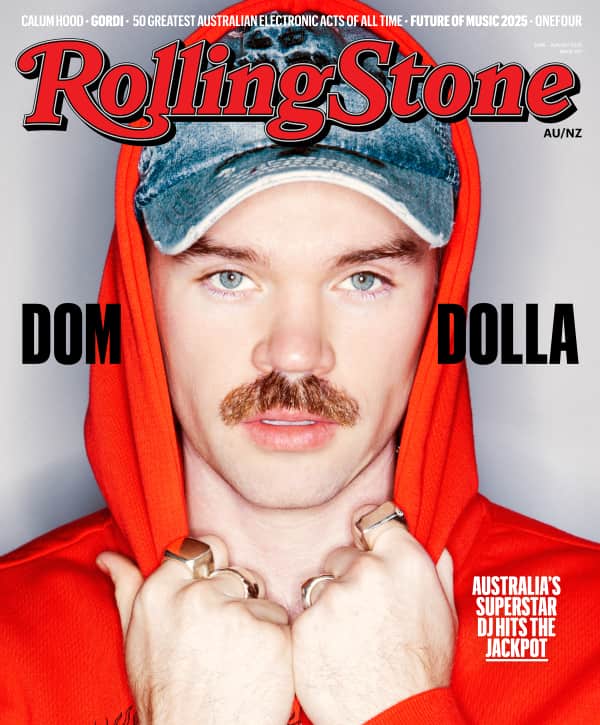Few Australian artists have experienced the incredible level of international success achieved by singer-songwriters Tones And I and Luke Steele. Their songs have become ubiquitous parts of the cultural fabric, connecting with a truly staggering number of people from all over the planet.
Tones saw her breakthrough hit “Dance Monkey” reach Number One in dozens of countries; in Australia it spent 24 non-consecutive weeks at Number One on the ARIA Singles Chart, breaking the previous record (Ed Sheeran’s 2015 hit “Shape of You”, which spent 15 weeks at Number One). It has also been played on Spotify over three billion times, making it the most-streamed song of all time by a female artist on the platform.
Steele had already found an audience in Australia in the late-Nineties and early-Noughties with his band The Sleepy Jackson, but it was Empire of the Sun, his electropop duo with Pnau’s Nick Littlemore, that took his music to the masses. Signature hit “Walking on a Dream” has been streamed over a billion times and went Platinum in the US and UK; in Australia it went 10 times Platinum.
The duo has a lot more in common than being global chart conquerors: both artists have released new music in 2024 — Tones with second album Beautifully Ordinary, Steele with the fourth Empire of the Sun record, Ask That God — and have been playing shows to packed crowds around the globe. They both understand the need to exceed expectations and deliver the goods while being under intense public scrutiny.
During their revealing Musicians on Musicians chat, held at Sun Studios in Melbourne — the first time the pair have met in person — Tones and Steele trace their inspiring journey from humble beginnings as hard-luck buskers to writing songs for the likes of Rihanna and Beyoncé, providing valuable insight into how artists can survive and thrive in the music industry with grace and sanity intact.
Love Music?
Get your daily dose of everything happening in Australian/New Zealand music and globally.
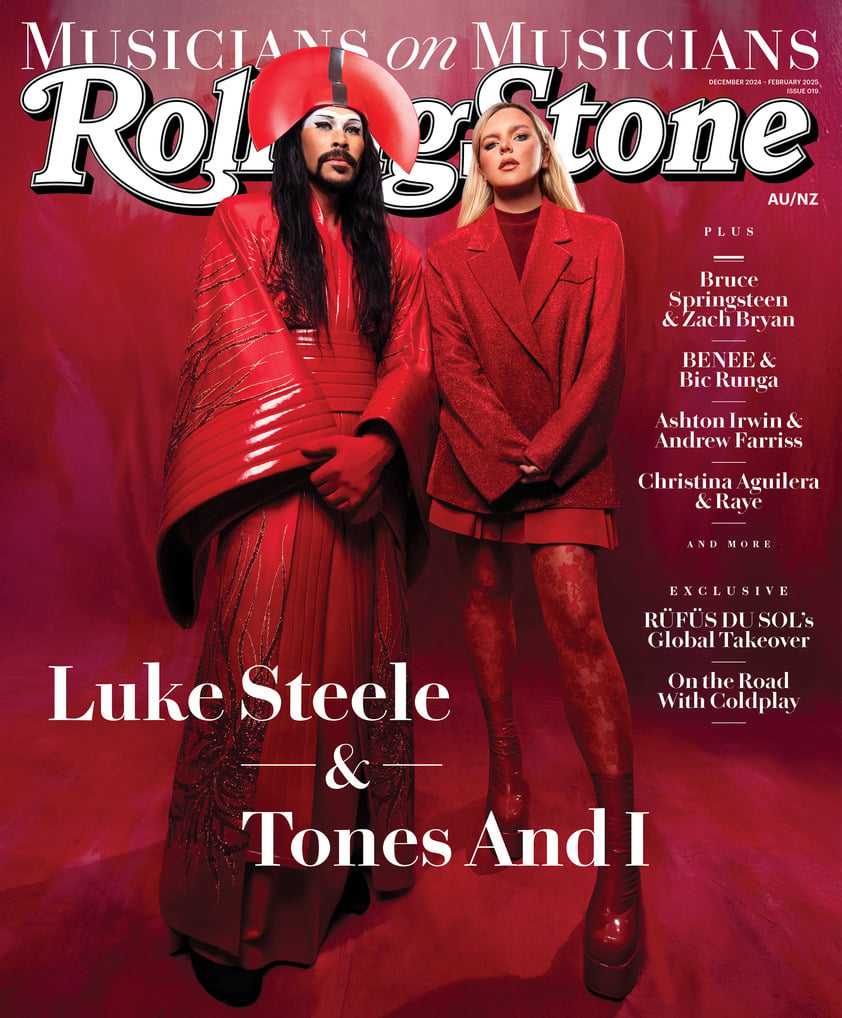
Tones and I & Luke Steele photographed at Sun Studios, Melbourne Feature Writer: James Jennings Creative Direction: Katie Taylor Photography/Post-Production: Giulia Giannini McGauran Set Design: Giulia Giannini McGauran and Shanahbelle Macdonald Assistance: Izaac Margin and Michelle Grace Hunder TONES AND I HMU: Natalia Poposka Tones and I Styling: Toni Watson Empire of the Sun/Luke Steele Styling & Creative Direction: Snaps Luke Steele HMU: Belle Morganne
RS: How are you guys feeling about your Rolling Stone cover shoot?
Steele: The colours are powerful. I think red’s a good colour for this shoot, with what’s happening in the world right now. It’s a power colour, it’s a call to arms. It feels like we’re going into a battle right now in the world, a battle for peace. Let’s bring the fire!
Tones: Yeah, absolutely! I love that.
RS: You’ve both achieved huge global success. How has that impacted your songwriting?
Steele: What I’ve realised after touring the world is people love things that are simple. They love melody. I think children are usually the best judge. When my kids are singing the hook, that means that probably 10,000 people are going to be singing that [at a show] as well.
Tones: My biggest song [“Dance Monkey”], that’s accumulated over six billion streams, was written with four loops. That’s how I wrote music and that’s how I still write music in the studio today. Not with four loops, but with loops. I write whole orchestra parts now with the same $300 keyboard and the same loop pedal. I think a lot of songwriters were surprised to know that I was playing that song on the street for a year with four loops and then just took those four loops into a studio and wrote the biggest song in the world by a female artist. And you’re right, the children are the reason that that song did what it did. No one’s going to listen to a song more than a kid on repeat. And that was a simple song made in half an hour. I didn’t see the necessity to overcomplicate it once I stepped into a studio. Don’t sit there for months and months thinking you need to add more. If you’re happy with it, that should be enough. I don’t know why we seem to ask for a lot more people’s advice as we become more successful. We need to trust our own ability more.

Steele: Yeah. Follow the heart. When we wrote “Walking on a Dream”, it was a similar thing. Bob Dylan says you’ve got to catch your inspiration, kind of like you’re catching wild fireflies. Because it just flows in the room and it might only be for a split second. In terms of songs, I keep seeing it’s the simple, big melodies that people remember. Even going back to The Beatles’ melodies where they’re like nursery rhymes, in a way. It’s kind of funny when you break it down, it’s like singing “Happy Birthday” or something.
Tones: [People need to] get more honest. It’s not really about being surprised [by music] these days, it’s about being inspired. The big, huge production, it’s not really shocking anyone. I think what’s real is shocking people.
Steele: A couple of years ago I did this solo record which was kind of country songs, and my wife interviewed me and she asked, “If you went back to when you were 20, what would you change?” I said, “Absolutely nothing.” I’d smash hotel rooms; I’d get totally drunk and destroy everything. I would play shows, break all my guitars. I would do that, but that’s what makes an artist — that edge, that danger. It’s true that youth is wasted on the young, but that’s what creates such a beautiful narrative. Embrace the youth, embrace the danger!
Tones: I can’t say I’ve ever done that. However, there’s still time!
Steele: I can’t change any of that now…
Tones: I’m not judging you. I lived in my van at a hostel. I can’t even say I smashed up my van! I’m trying to think of something.
Steele: That’s such a beautiful story, you know. In the van and driving the coast and just playing. It’s courageous. They say fortune favours the brave. You’ve got a lot of courage doing that. And as a woman, as well. Because I used to busk in Perth, and people would come and throw cigarette butts in [my guitar case].
Tones: That’s actually so interesting to know. There was one night where I had someone push my keyboard off the stand and a guy stole my money. And the crowd, they just kept yelling “one more song,” which you would think would be a compliment, but [the show] had been going for an hour and 50 minutes. I was trying to take a 10-minute break. They didn’t care to have me speak or introduce myself, and they were chanting over me. So then I went home, and I wrote a song. And that song just had the most common things that were told to me on the street. “Oh my god, I see the way you shine.” “You stopped me dead in my tracks while I was walking by.” “Please, just sing one more time.” The chorus was, “sing for me, sing for me, sing for me.” I just changed it to “dance” to make it more universal, and that became “Dance Monkey”, which just describes one of my more tougher nights of busking.
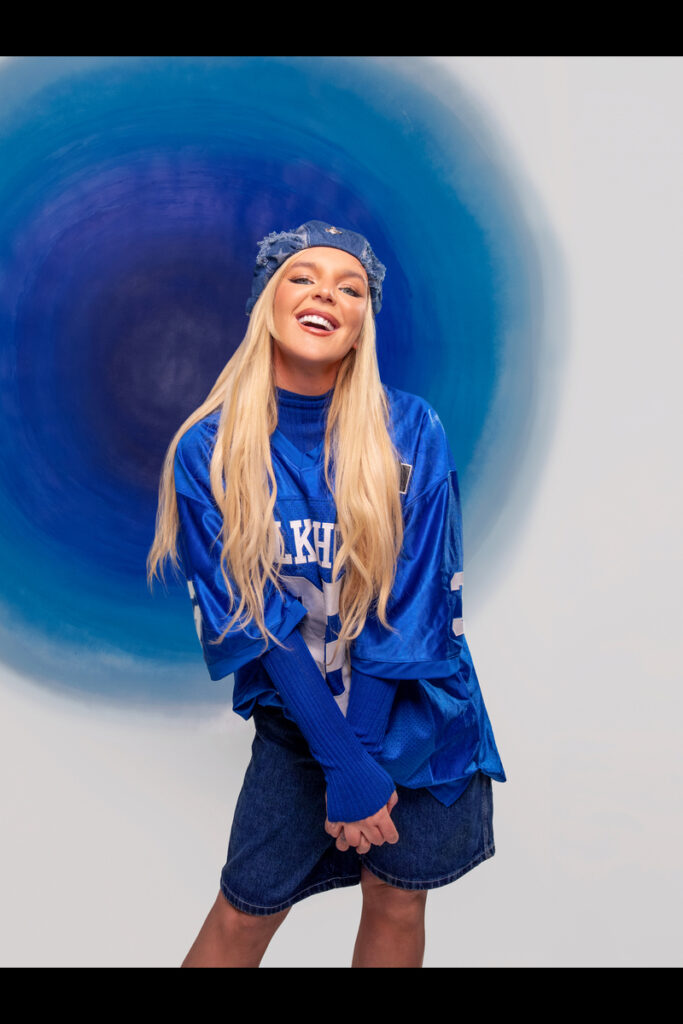
Steele: Yeah, that’s amazing. That’s a story.
Tones: Busking is tough and I respect anyone that does it. Because even just setting up and finding your spot, that can be the most nerve-wracking part.
Steele: Dealing with the demographic as well, that would have trained you pretty good. I grew up in a blues club — my father is a musician. So ever since I could walk, my main outings with my father were picking up the PA and going to his shows. And then some pubs we’d get to on the outskirts of Perth, it’s all bikers. It’s all people pretty out of it. And I’d look at him and go, “How are you going to deal with this?” And he’d come up, and he’d have a massive repertoire. He’d have jokes, things that you could break the ice with people, and pull it off.
Tones: How old were you when you were watching?
Steele: Ever since five, six, seven. And then when I got to 14, in the middle of a show at the blues club in front of 500 people, my Dad would go “Oh, my son’s here. He’s going to get up on stage.”
Tones: So you’ve really had a lot of practice just becoming comfortable in these kinds of situations.
Steele: Yeah. So it’s a similar kind of scenario with busking, really, where you’re dealing with a lot of different people.
Tones: Do you remember your first show?
Steele: It’s funny — we drove past it the other day. It’s in a place called Northbridge in the heart of Perth, and it’s a bandstand in the middle of a park. And it was the worst gig ever. My guitar was out of tune. I didn’t have my tuner, and I was using a little outdoors amp that sounds like you’re playing through an iPhone.
Tones: I know that feeling. I’ve had to use a little Bose speaker one time to busk.
Steele: When you’re young you get so nervous, it’s like you’re having an epileptic fit. You’re so nervous, and you’re trying to pick up your guitar.
Tones: How did you feel playing in front of your dad? From watching him to him watching you.
Steele: I had him [on stage with me], and he’d kind of lead the way, so that was a lot less stressful, plus there’s a six-piece band behind you. I’d just jump up and do two or three songs as this Stevie Ray Vaughan, guitar solo kind of guy.
Tones: Do you feel like you owe some of your success to your dad?
Steele: I think my father was the catalyst. Because, in a roundabout way, he taught me all of the essentials. He’d always say “you’ve got to know that first song, what you’re going to say, what you’re going to do. Know where you’re performing, what’s the audience,” all those basic things that a lot of people forget.
Tones: After a while did you start realising, “OK, we’re getting successful here. This is really something that I’m going to do, I can feel things taking off.” Because there’s a feeling. You start getting more streams, things start happening more rapidly. I’d also like to know your highest point, but also your lowest.
Steele: I think my rise was the complete opposite of yours. It was gradual. When I started, I was really getting into making my own songs and working hard to have them translate live, and it was terrible. And then it got better. In the early days of The Sleepy Jackson, when I was 19, I put so much pressure on myself that I had to make it. And then the whole thing fell apart, and I completely fell apart myself. I got so depressed, I wanted to live underground. I spent about eight months basically trying to disappear until my brother kind of saved me, and then I just basically rebuilt things. At the start of my twenties, I began again. So yeah, it was quite a gradual climb. Things would just keep being honed and finessed, as opposed to what you went through, where it was at a very young age with a worldwide Number One hit.
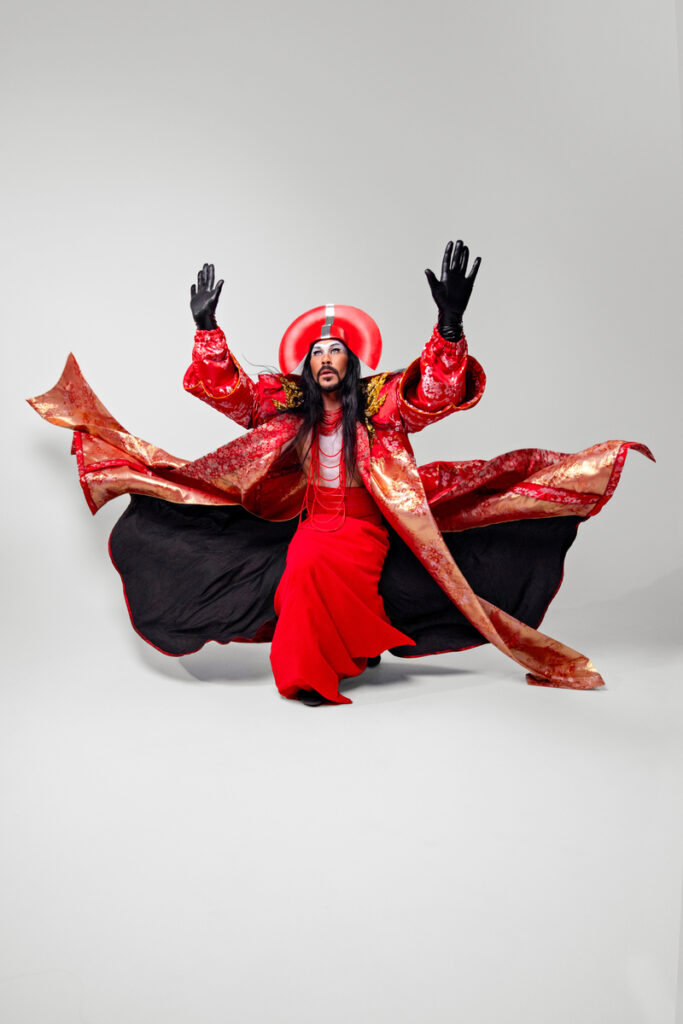
Tones: I think you definitely were more prepared. With one hit can come a big incline and a big decline. I think my best moment would probably be seeing other songs [than “Dance Monkey”] do well. Not only here, but overseas. To some people, I’m just that “Dance Monkey” girl, and I’m OK with that. But I think with that quick incline, there’s always going to be a very quick decline. And it’s now up to me to keep this thing afloat.
Steele: I wonder how you made it through with how intense that was. Because my best friend Daniel Johns from Silverchair, when he had a big hit [at a young age], the stories… People would pull him aside at school, put him in a van, beat him up, and then they would hound him. He had girls camping out the front of his house. It became so much that he was like, “I’m going to stop eating.” The pressure and things that he went through, it was so intense. How do you deal with that?
Tones: I get school kids that come around to my house and ask for free merch. It’s always the same kid: “Lucas, you’ve been here three times this week,” on the intercom. He’s always trying to bring more friends to get more free stuff.
Steele: You just open the door and they’re standing there?
Tones: No, usually I take it out to the front gate. But you know, they’re harmless. I’m definitely not as big as what [Silverchair] was. I think I’ve only really started having proper fans this year. I had people who liked some of my music, but now it’s actually fans with [social media] edits and people sending things to my house and whatever. [Looking at you], to be able to have longevity in your career like that is such an aspirational thing.
Steele: Music… it’s so beautiful and songs become like your best friend. I don’t know if you’ve heard of Es Devlin, but she’s a famous set designer and she said, “You’ve got to remember when you’re performing that the songs belong to the people.” I love that. You let the songs go and the audience then owns them.
Tones: You take your last moment with them before release day.
Steele: Yeah, exactly. And then it becomes theirs, their friend. It’s so beautiful. Have you ever written in Nashville?
Tones: No, I’ve never been there but I’ve heard about it non-stop.
Steele: You should go to Nashville! The songwriting teams there, they sit down and they don’t leave until they write a song. They always write incredible songs that sound amazing. Then they go to the next session — two hours, three hours max — they write another incredible song. They do that three times a day, five, six days a week.
Tones: I’ve done the writing camps, just not in Nashville. I’ve done it in Vegas and LA.
Steele: Nashville is a whole world unto itself; it’s like a separate songwriting planet where songs go to be written and die in the same place.
Tones: The vibe I get from big songwriting camps is that if a big artist doesn’t want to take this song, then it will die and it sits with the publishing company in a vault or whatever.
Steele: That’s like Rihanna. Every songwriting session you do in Hollywood is “who are you writing for?” “Rihanna.”
Tones: Me too! I’ve done that too.
Steele: Rihanna has literally 360 million songs, like I think she’s got too many songs, she doesn’t know what ones to sing.
Tones: Every songwriter has done the Rihanna songwriting. I’d love to know which ones she picks in the end. I’ve got about 20 friends that have all written music for her, hopefully it’s one of them [laughs].
RS: Maybe you’ll both get songwriting credits on the next Rihanna album?
Tones: Yeah, that would be crazy. I mean, one thing’s for sure — Rihanna’s album is going to Number One. She could fart on the track, it’s gonna go to Number One. I personally am a huge fan and will listen to that album no matter what, even if she releases it in 30 years. She’s such a strong woman and that is very inspiring to me.
Steele: It is strange where songs are concerned, because often it’s being in the right place at the right time. I wrote a song for Beyoncé on her 4 record and it was just the timing. She had the whole album, she needed one more song. I was with Jeff Bhasker in Santa Monica, and then we wrote this song and sent it to her. I wrote the lyrics from her perspective, talking to Jay-Z. It’s like, “You smoke too much, you drive too fast, you do all these kinds of things, but I’d rather die young than live without you.” She was like “love it!” Boom. So sometimes it’s just the right time and being hungry. Let’s start a new Nashville here!
Tones: We should! Start some writing camps down here, get some people to fly to us for a change.
Steele: I think that sounds like a plan. Rolling Stone should do a writing camp. You should have a Rolling Stone studio, that would be good. So anyone that comes in for an interview, just put them in the room with a producer for a day, write a song and record it.
Tones: I’m at a point in my career where I’ve had the peak, now I want to just tread water and be happy, and write music for other people. That’s a huge part of my career moving forward. And I want to learn from someone like Luke that has had a good career and continues to. That’s always the most inspiring thing for me because that’s all you could hope for as an artist.
Steele: That’s very respectful. Thanks, Tones. I feel the same way as well. I always still feel like a student. It’s funny, being older and having been through all these things, I still feel like I’m in high school, learning. I think collaboration and talking to artists is really inspiring. You hear the whole journey and it’s really quite fascinating.
Tones: I would love to see you work. As an aspiring songwriter, because I still honestly feel that way, watching other people work is the best way to learn.
Steele: Absolutely.
Tones: I feel like you’ve spoken so well and been so open and I’ve loved chatting to you.
Steele: Likewise!
This feature story is in the December 2024-February 2025 issue of Rolling Stone AU/NZ. If you’re eager to get your hands on it, then now is the time to sign up for a subscription.
Whether you’re a fan of music, you’re a supporter of the local music scene, or you enjoy the thrill of print and long form journalism, then Rolling Stone AU/NZ is exactly what you need. Click the link below for more information regarding a magazine subscription.



























